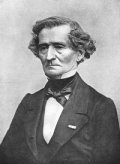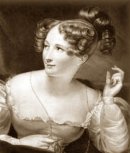
Hector Berlioz
Hector Berlioz is quite possibly the most underrated composer and orchestrator ever. Nikolai Rimsky-Korsakov and Richard Strauss get their orchestrations raved about, but one can clearly hear imitations of Berlioz (conscious or not) in their music. Rimsky-Korsakov wrote a fantastic treatise on orchestration but Berlioz's came first.
Unfortunately, Berlioz falls by the wayside. His lifetime featured the death of Beethoven, the birth of Brahms, and the heyday of Mendelssohn. The program work music that tells a story became a fashionable and popular form of music, one that Berlioz did very well. What Haydn did to the symphony, Berlioz did to the program work.
This 2-disc set features one of Berlioz's chief interpreters Sir Colin Davis performing three symphonies, and two of the best overtures of the 19th century.

Nicolo Paganini
In 1833, virtuoso violinist and fellow composer Nicolς Paganini was impressed with Berlioz's compositions, and since he had recently acquired a viola of the famed Stradivarius line, he commissioned Berlioz in 1833 to write him a concerto. Berlioz, however, had one of his program symphonies in mind an idea that became Harold en Italie.
The worst thing that can happen in a recording of a work such as this is that the soloist can try to turn the part into a flashy 19th century romantic concerto, but thankfully Nobuko Imai doesn't fall into the trap. The symphony features Harold, given voice by the solo viola, literally personifies romanticism the conflict inherent in the need for the romantic ideal of freedom that gives inspiration to the brooding opening bass and cello line.
In anticipation of Wagner's leitmotif, Berlioz lets a theme represent Harold, which is the first theme presented by the viola, and the symphony basically tells of Harold's observations and participations in various Italian vignettes here may I take the liberty of reminding the reader that Harold is the physical personification of romanticism.
Paganini initially refused to perform it, unhappy with the small amount of playing time he had he had paid for a large-scale, difficult, romantic viola concerto, and the viola barely made a brief appearance in the finale. Upon hearing it though, Paganini was reminded of his love of Berlioz's music, and included the full commission with a letter beginning thus: “
Beethoven being dead, only Berlioz can make him live again”.

Harriet Smithson
The
Symphonie Fantastique was conceived as a result of Berlioz's meeting with Harriet Smithson. Smithson's theater company was visiting Paris in 1827, and Berlioz, upon seeing her act, fell head over heels into infatuation, and married her, a failure matched only by Peter Tchaikovsky's marriage.
Berlioz wrote his most famous programmatic symphony, first performed in 1830, as a response to it:
Episode de la vie d'un artiste: Symphonie Fantastique en cinq parties. Roughly translated, it means Episode in the Life of an Artist: A Fantastic Symphony in Five Parts.
In it, Berlioz's hero has taken opium because of an ill-fated love, hoping to die. Instead, he begins to have wild phantasmic visions of his lover. As in
Harold en Italie, Berlioz lets a single musical idea represent the love of the hero something he called the
idιe fixe that shows up in every movement.
The first movement begins with a short woodwind passage (coincidentally, the orchestration happens to be almost exactly the same as the woodwind chords in the opening of the first movement of Rimsky-Korsakov's Sheherezade) before the violins introduce the
idιe fixe. The first movement does not have a program per se (it is subtitled "
Reveries Passions"), and does not prominently feature a musical structure. The main purpose is to introduce the
idιe fixe, and to demonstrate the hero's unrequited love.
The next three movements depict various sequences culminating in the hero believing he is about to be executed for murdering his obsession in the fifth and final movement. The theme quoted by the trombones near the beginning is the
dies irae, a medieval theme, which has come to be the musical personification of death (it was used in the beginning of the Stanley Kubrick film The Shining).
Berlioz's
Symphonie Funebre et Triomphale was commissioned by the reactionary 1830 French government in an attempt to stir patriotic fervor and avoid revolution. The attempt failed, but not because of the music. Featuring Berlioz's orchestrating skills at his very finest, in it you can here the influence Berlioz might have had on such composers as Shostakovich.
The two overtures in this set are the Roman-Carnival Overture, and the Corsaire Overture, two of the most famous overtures of the 19th century, and they are both derived from previous works. The Roman-Carnival from the opera Benvenuto Cellini, and the Corsaire from The Red Rover.
The Roman-Carnival overture in particular is among the most difficult orchestral repertoire. It should not drag, but neither should it rush, but it very willingly does both. It is in 6/8 time, meaning that there are six beats per measure which in this case, are joined into two divisions of three per measure, which makes for one of the most difficult time signatures to follow, and Berlioz doesn't make things easier by including many off-beat entrances and pickups it's so incredibly easy to fall behind, but the London Symphony Orchestra plays it flawlessly. Colin Davis often lets the brass sound plateau, which often results in a blaring sound rather than a powerful sound, but this is the only consistent problem.
The one real disappointment with the disc though is when the choir comes in at the end of the
Symphonie Funebre et Triomphale. It sounds like the choir has been remastered by the sound engineers to equal the orchestra decibel per decibel when it should tower impressively above the orchestra. That's the only negative I could find though, the wind section is marvelous, and the strings just tear through those challenging passages Berlioz presents them with.
The recordings are quite old, some dating back to 1965, but they sound like they could have been recorded yesterday. Great music and great performances it doesn't get much better than this.
Please support Good-Music-Guide.com
by purchasing this CD using this link.

Track Listing
Hector Berlioz
Great Orchestral Works
Nobuko Imai Viola
John Alldis Choir
London Symphony Orchestra
Sir Colin Davis
Disc 1
Symphonie Fantastique, Op. 14
- Reveries Passions (Largo-Allegro agitato e appassionato assai)
- Un bal (Valse. Allegro non troppo)
- Scene aux champs (Adagio)
- Marche au supplice (Allegretto non troppo)
- Songe d'une nuit de sabbat (Larghetto Allegro Ronde du sabbat: Poco meno mosso)
- Le Carnaval Romain, Op. 9 (Overture)
- Le Corsaire, Op. 21 (Overture)
Disc 2
Harold en Italie, Op. 16
- Harold aux Montagnes (Adagio)
- Harold aux Montagnes (Allegro)
- Marche des Pelerins chantant la priere du soir (Allegretto)
- Serenade d'un montagnard des Abruzzes A sa maitresse (Allegro assai Allegretto)
- Orgie des brigands, finale (Allegro frenetico Adagio Allegro. Tempo I)
Symphonie Funebre et Triomphale, Op. 15
- Marche funebre (Moderato un poco lento)
- Oraison funebre (Adagio non tanto Andantino un poco lento e sostenuto)
- Apotheose (Allegro non troppo e pomposo)